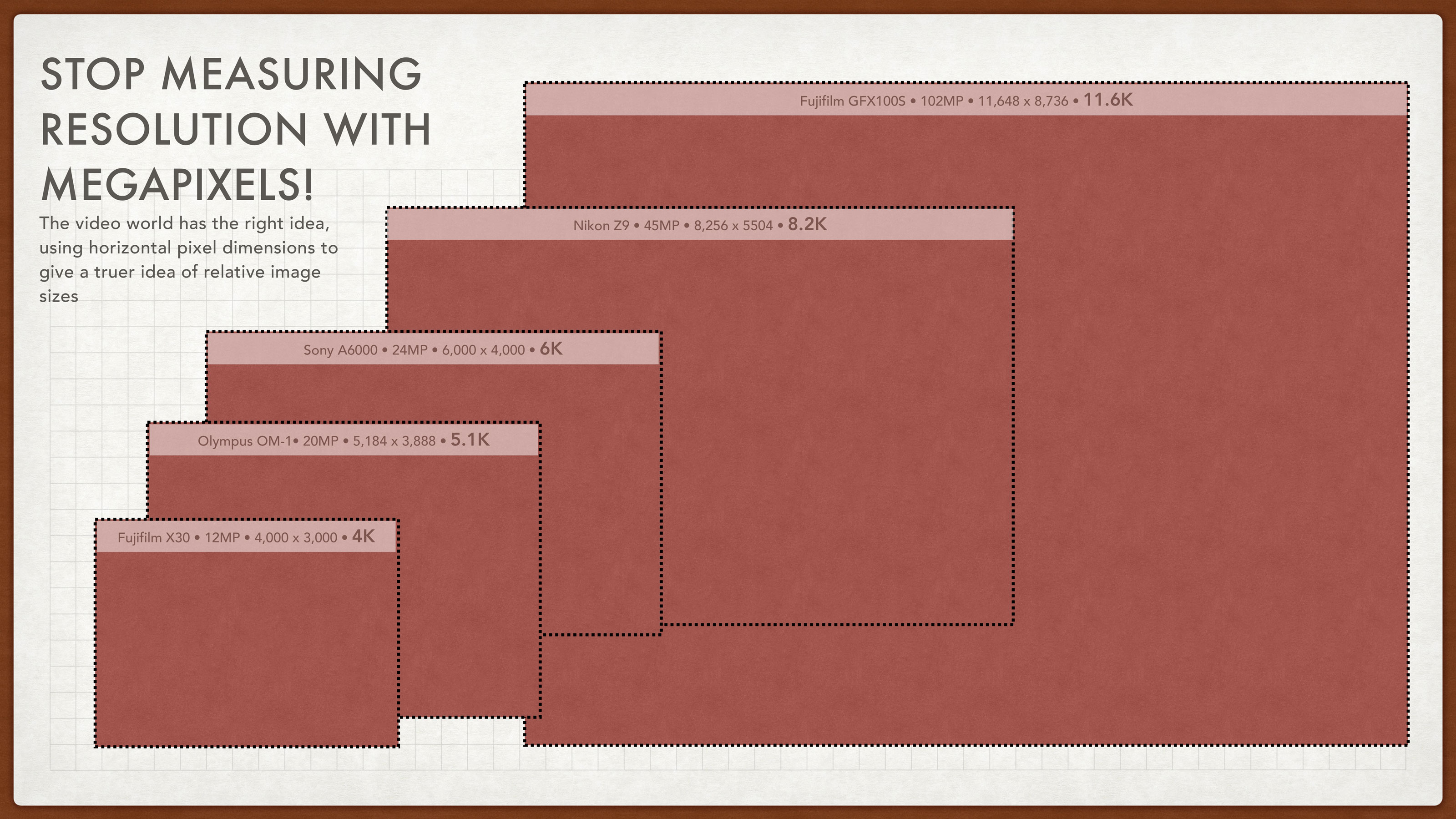We should stop measuring resolution with megapixels!
The video world has the right idea, using horizontal pixel dimensions to give a truer idea of relative image sizes

Digital camera makers have been using megapixels as a measure of camera resolution since they were first invented. The trouble is, it exaggerates the differences between cameras in a way that doesn’t exactly reflect real world usage.
The problem is the maths. Megapixels only tell you the size of the image in terms of area, but what most of us want to know, most of the time, is how wide or tall it will be.
This is the most important measurement for web design, creating presentations, slideshows, wall prints, commercial publishing and even for using stills in movies.
The fact that Nikon Z9 has 45.7 megapixels tells you nothing. What you actually need to know is its horizontal resolution so that you can directly see its relation to 8K video and work out how big a print you will get at a standard 300dpi print resolution (27.5 x 18.3 inches – not bad!)
Why megapixels exaggerate differences
What we’re mostly interested in is how wide the image will be, or how tall, not both multiplied together. If you just go by megapixels, the 45MP Nikon Z9 sounds like it will produce images twice the size of a Sony A6000 (give or take 3MP).
It won’t. In fact, if you double the megapixels, you will only get an image 1.4x wider. The image area will be 2x larger, but its width and height won’t be.
Why the video industry has got it right
Admittedly, with standard and full HD the video industry still quotes the vertical resolution (720 and 1080 respectively), but beyond that it’s swapped to horizontal image resolution – and it certainly makes image sizes a lot clearer.
Get the Digital Camera World Newsletter
The best camera deals, reviews, product advice, and unmissable photography news, direct to your inbox!
This doesn’t apply solely to video. Very often you’ll want to know the image width for stills photography too, for reasons we’ve already discussed above.
So why not look at camera resolution in video terms instead? Our diagram above shows a handful of different cameras and resolutions and how this equates to actual width and height, not both multiplied together.
Note that our diagram does not show relative sensor size, only relative image size.
Cameras are better/closer than we think
So the smallest camera in the diagram is the old Fujifilm X30 compact with ‘only’ 12MP. Yet with a horizontal resolution of 4,000 pixels, it can still shoot 4K stills – easily large enough to fill all but the highest res screes, enough to insert into 4K movies and plenty for social sharing and almost any kind of web design.
Going by horizontal resolution, the new Olympus OM-1 has a 5.1K sensor, the Sony A6000 family has a 6K sensor, the Nikon Z9 is 8.1K and the mighty Fujifilm GFX100S has an 11.6K sensor.
Looking at it this way gives a much truer sense of relative image sizes. It’s interesting to note, for example, that the Nikon Z9’s images are just twice the width in pixels of the little X30’s.
Camera makers like big numbers, of course, and megapixels are the biggest numbers of all. But they do exaggerate differences between cameras and megapixel ratings don’t tell you directly what your image width will be in pixels – which is probably what you really want to know.
Read more:
• Best filmmaking cameras
• Best 8K (and 6K/12K) cameras
• Best photo printers

Rod is an independent photography journalist and editor, and a long-standing Digital Camera World contributor, having previously worked as DCW's Group Reviews editor. Before that he has been technique editor on N-Photo, Head of Testing for the photography division and Camera Channel editor on TechRadar, as well as contributing to many other publications. He has been writing about photography technique, photo editing and digital cameras since they first appeared, and before that began his career writing about film photography. He has used and reviewed practically every interchangeable lens camera launched in the past 20 years, from entry-level DSLRs to medium format cameras, together with lenses, tripods, gimbals, light meters, camera bags and more. Rod has his own camera gear blog at fotovolo.com but also writes about photo-editing applications and techniques at lifeafterphotoshop.com
